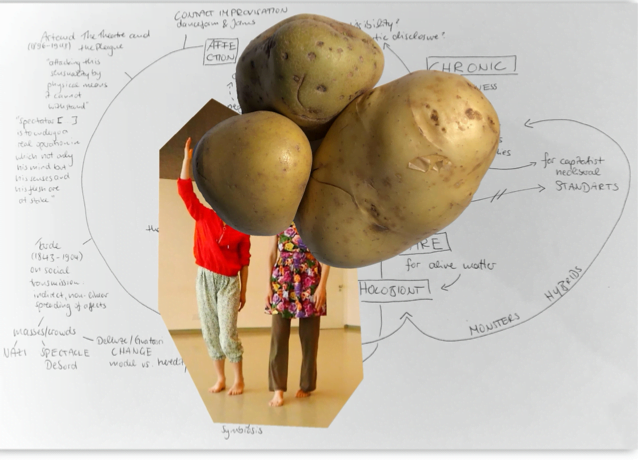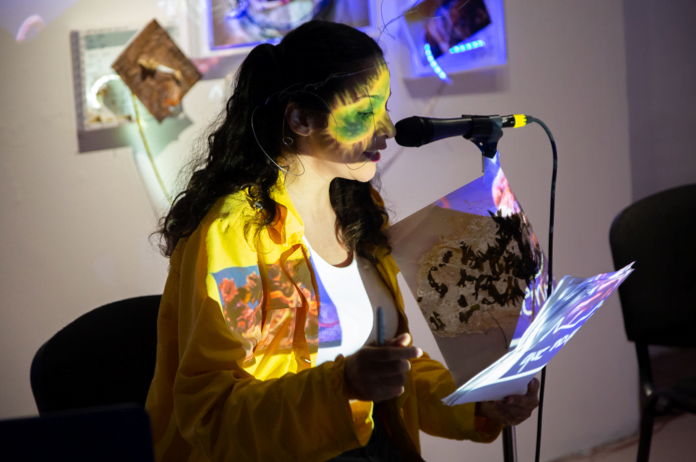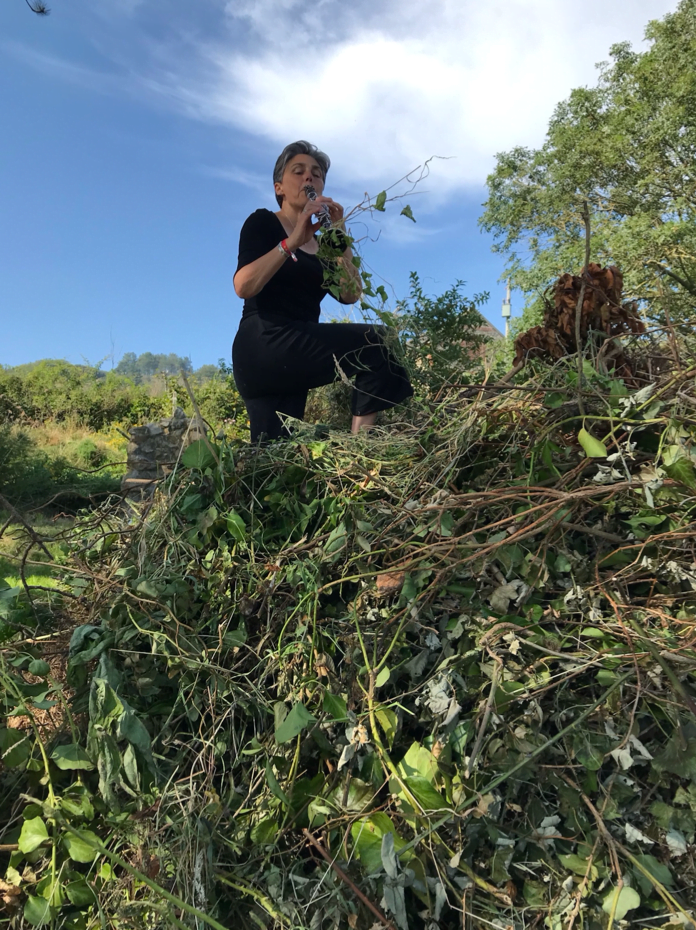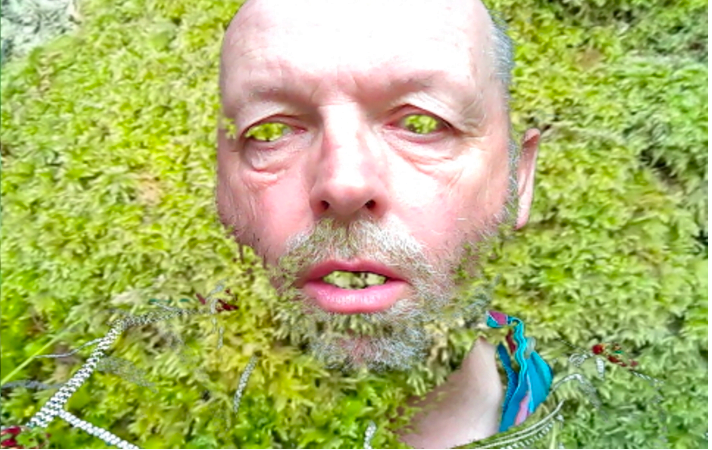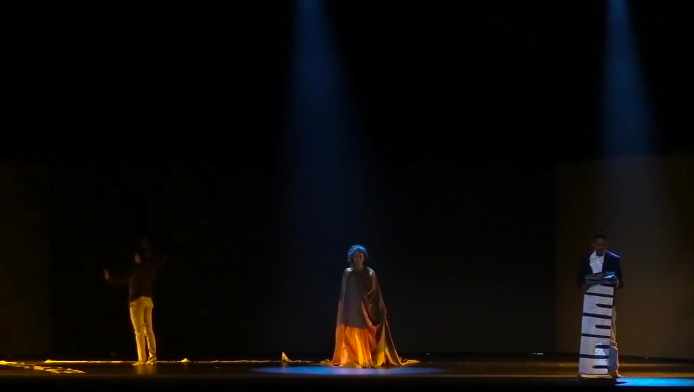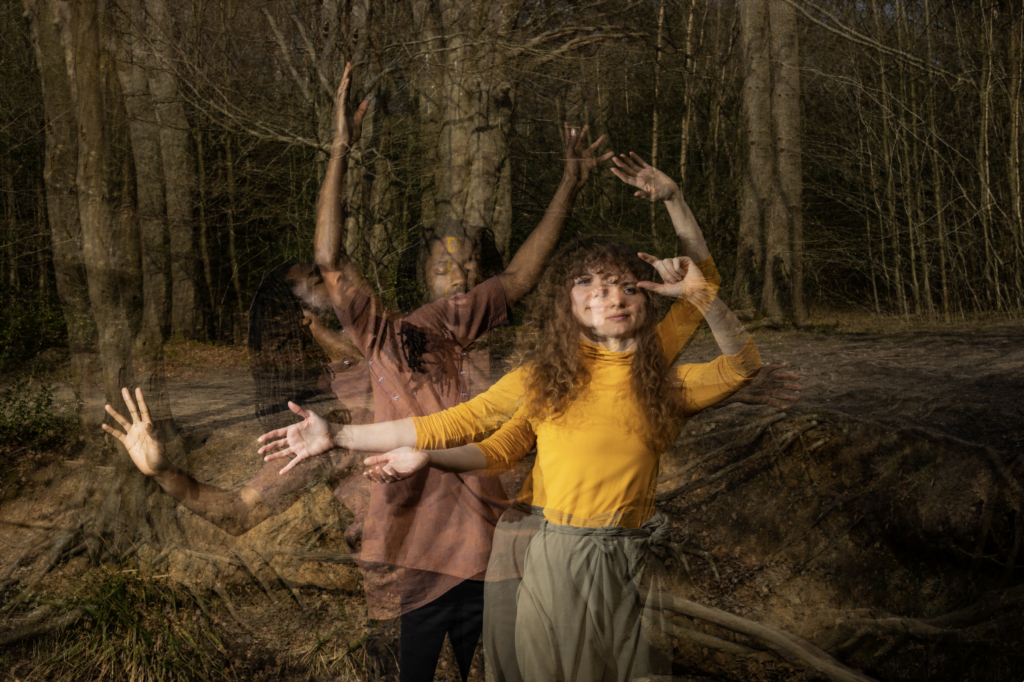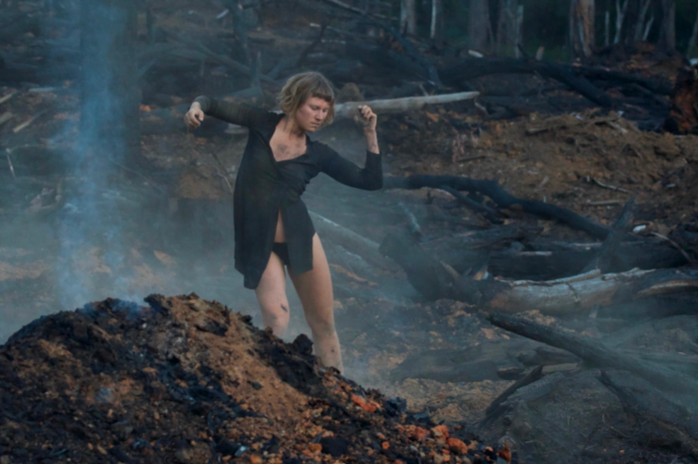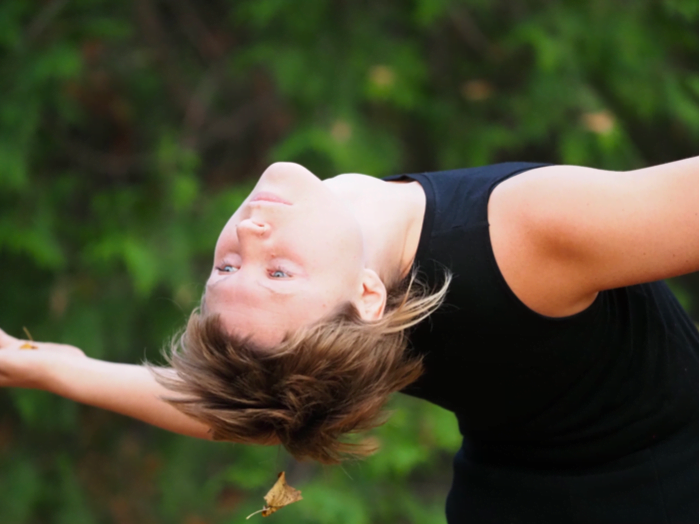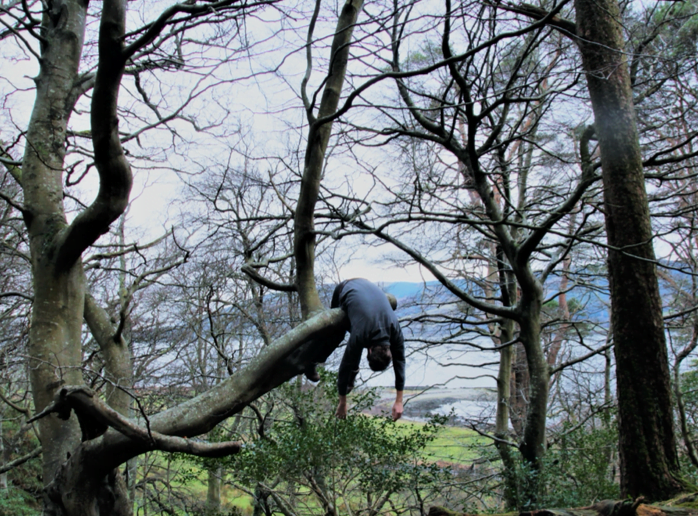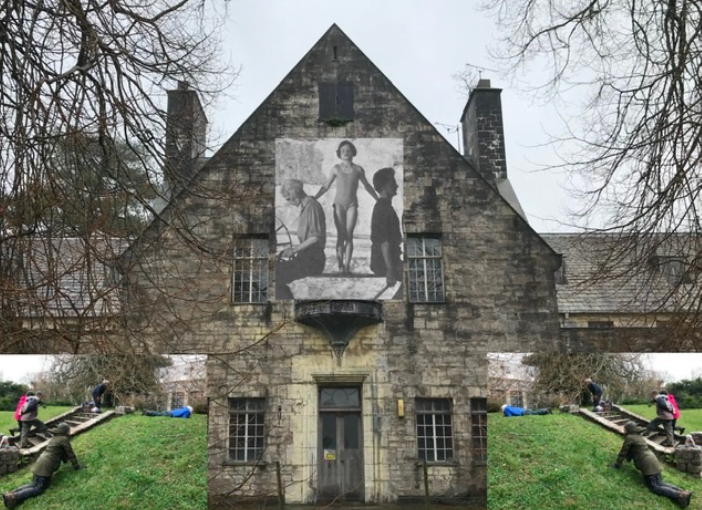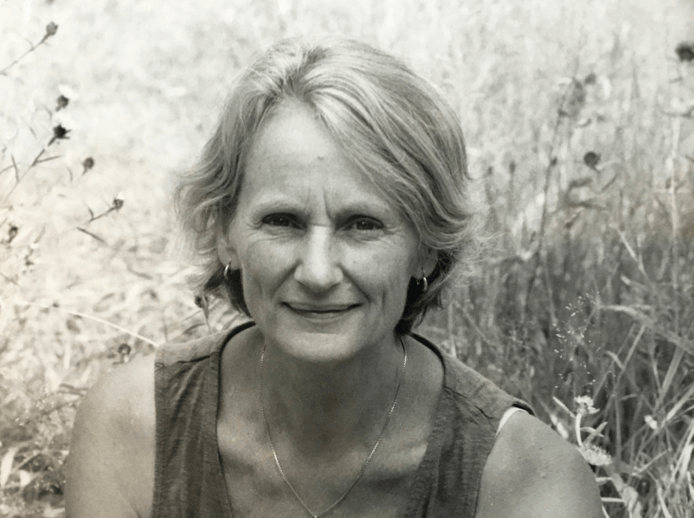We are so excited to be offering 15 performances in and outside during Sentient Performativities!
A HUGE Thank You to all performers who are sharing their work with us in intimate and powerful ways.
Here is the outline information. More detailed information to follow:
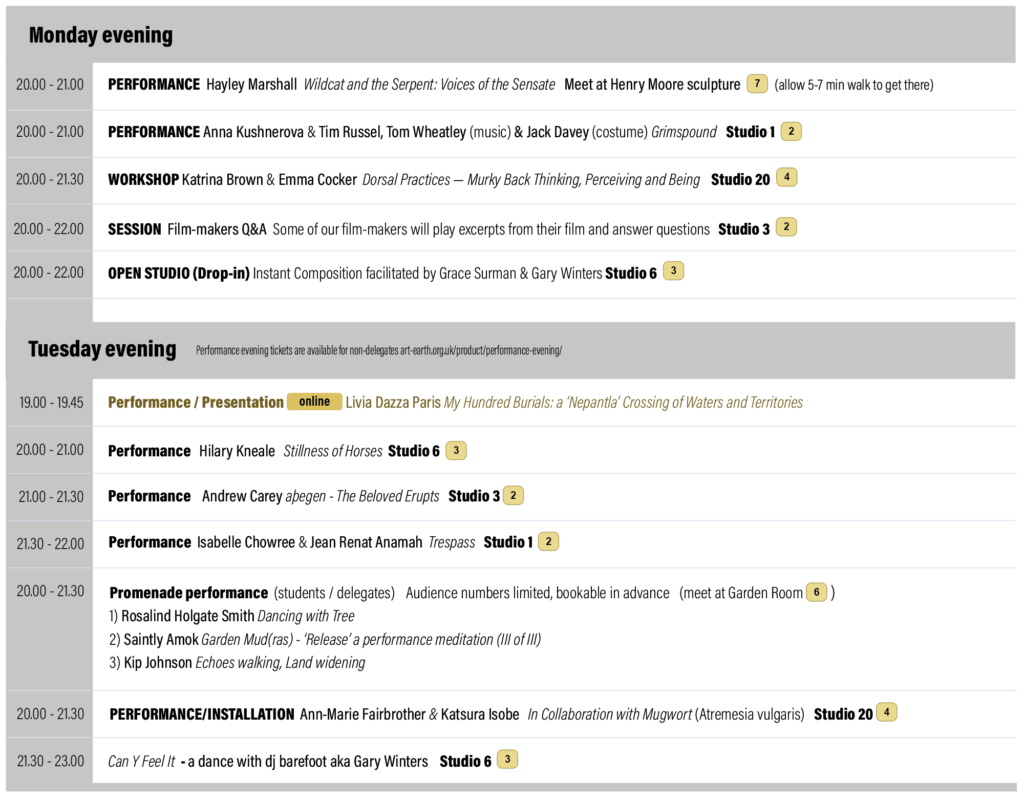
Sunday evening
20.15 – 11.15 Emma Welton & Tony Whitehead – HABITAT: music at the end of the day (dusk chorus) in the gardens.
Emma Welton & Tony Whitehead
Co-curators Emma Welton and Tony Whitehead were drawn together by their shared love of quiet listening both within and outside concert halls. We conceived A QUIET NIGHT IN in 2014 to perform concerts of quiet contemporary music otherwise neither performed nor widely-known in Devon. An antidote to musical performances in noisy bars and club-type settings, A QUIET NIGHT IN provides a context for the exploration of the creative possibilities in quiet/silence. We consider carefully the quality of our listening experiences. We use different venues across Exeter and beyond and curate the programmes to best fit the space. We allow each venue its own moment of quiet, partly to help our audience settle into a state of attentiveness, but also because each venue has its own audible character and this is worth hearing. We strike a balance between some of the more challenging quiet music of, for example, James Saunders and Wandelweiser composers, and the calm directness of, for example, Howard Skempton. We are also interested in music that contains a certain attitude toward discovering, revealing and permitting sounds such as Joanna Bailie’s Artificial Environments – with its recordings of everyday sounds combined with live instruments – and Alvin Lucier’s exploration of the acoustic properties of objects, rooms and materials. We invite people to compose new quiet pieces for our concerts. Programmes have included playfulness and humour alongside intense introspection.
At the end of the day, a collective act of listening and sound-making.
We will attempt to become part of the flow of sound from daylight to dusk, blending with what we hear, and adding to it by making our own sounds, responding to what we hear and to each other. You don’t need to be a musician to take part, and we will have a few sound-making things for you to borrow – although you can also bring your own things. We will have a simple set of instructions for you to follow – our ‘score’ for the performance. And you can of course just come and listen if you’d like, and be part of the performance in that way.
MONDAY PERFORMANCES
Saintly Amok: Garden Mud(ras) – (I of II) ‘Emerge’ a performance meditation
When: Monday 7:00 – 7:30 am
Where: the flower bank outside the garden room
I will create a series of ‘mudra’ drawings based on my experience of the plant life cycles as observed through growing vegetables and the intersection with the ‘mudra’ tradition as found in ancient Hindu scriptures. Audiences are invited to become aware of the plants surrounding them in the environment as I create artworks inspired by the plant life-cycles, from germination to flowering, fruiting, seeding, and decomposing. After creating the artworks, I invite the audience to join me in a mudra exercise which they can hold for five minutes as a meditation. The first performance ’emerge’ takes place early in the day, the second performance ‘bloom’ takes place after midday, and the final performance ‘release’ takes place just before sunset. Audiences may wish to bring a blanket or something to sit on whilst watching and participating in the performance and meditation, and a warm layer as it takes place outdoors. The work seeks to rekindle our use of our hands in growing, picking, cooking and eating the food we consume. Mudras are an ancient practice based on the belief that energy channels corresponding to the elements of fire, air, space, earth and water, are controlled through our bodies, and that hand gestures called ‘mudras’ can be used to elevate or supress these channels. Modern life binds our hands into gestures that are less and less varied, and reduced to the actions of finger taps or swipes. This performance celebrates the hand gestures we use in growing plants and the knowledge our bodies build by being in contact with each part of the cycle from sowing seeds to composting vegetation.
Mita Solanky is a UK based artist whose art seeks to reconnect the human experience with nature. Her work encompasses live performance, installation, participatory and visual art. Mita undertakes artist residences in rural locations that allow her to experience the natural environment to direct her practice. Her work has an ongoing concern around the loss of knowledge that the body acquires by being in nature and using natural materials and processes. Her artworks range from those created through a recording of the body, to live performance and participatory installations. Her influence comes from ancient traditional and aboriginal nature- based practices and are critical of the synthetic environments of the contemporary human condition. She has a personal yoga and meditation practice that informs her performative works. Mita is based at the Leicester Print Workshop, Leicestershire where she lives and works, She studied Art foundation at City Lit, UAL, and has a previous background in Physics, having carried out research at CERN’s LHC. She was recently selected for the Flourish printmaking award 2022, and has exhibited work across the UK, including in galleries, museums and festivals. www.mitasolanky.org
Saintly Amok: Garden Mud(ras) – (II of III ‘Bloom’ a performance meditation )
When: Monday 13:45 – 14:15
Where: meet outside the white hart, the performance is taking place behind the white hart restaurant – on the private lawn
Eugenia Eréndira Gómez Espinosa : Conxerta for a forest – (or what do ants say when they defend their territory)
When: Monday 17:00 – 18:00
Where: Studio 1
An ethologist parasitizes her own scientific discourse with onomatopoeia of non-human species and sonorities of nature, poems and videos. Through attentive listening to ecosystems and the translation of their sounds into onomatopoeia, a scientist together with a musician, a bonsai tree and a fern present a primatological investigation intervened with still image, moving image, poems and direct sounds of species that are in danger of extinction: howler monkey howls, videos and sounds of humpback whales cooperating and making a bubble net to feed, moss growth and mountain gorillas playing. The hierarchies of scientific discourse are blurred to open the way to knowledge of the non-human as a way of symbolically traversing our body and exploring other ways of communicating. The performance conference is also a tribute to everyone, to those who defend their territory (humans and non-humans). It is created by the MUTANTE interlab collective, which explores the sonorities of the non-human (birds, mammals, molluscs) and their ingenious connections with the environment that surrounds them.
Production Credits:
Original idea: Erendira Gómez
Translation of sounds in onomatopoeias and audiovisuals: Eréndira Gómez
Text: Eréndira Gómez and Gustavo Schaar
Musicalization: Osiris Alcántara
Direction: Gustavo Schaar and Karla Camarillo
Interspecies collaboration: Juniper bonsai (Juniperus communi)s, Bird’s nest fern (Nephrolepis exaltata), Howler monkeys (Alouatta palliata mexiana), Humpback whales (Megaptera novaeangliae), Honey ants (Myrmecocystus mexicanus), Mountain gorillas (Gorilla beringei beringei), Anteaters (Tamandua tetradactyla).
Collaboration of bioacoustic recordings of mantled howler monkeys: Carolina Karvajal and Olga Domínguez
Production: Mutante Interlab
Eréndira Gómez: Born in the Bobos river basin, in Martínez de la Torre, Veracruz (July 1985). Doctor in Neuroethology from the Universidad Veracruzana and visual artist who investigates non-human languages ??of the Los Tuxtlas jungle and the cloud forest of the mountain. She is interested in integrating art, science, technology and ancestral knowledge of healing in inter/transdisciplinary pieces. Gustavo Schaar: Since 2020 he has been an actor in the stable cast of the Mexican National Theater Company. Between 2013 and 2017 he was part of the ORTEUV Theater Company. In 2018 he founded MUTANTE together with Eréndira Gómez, a permanent laboratory of contemporary art and multi/inter/transdisciplinary techniques. MUTANTE focuses on experimental and multi/inter/transdisciplinary theatricalities, its most recent production is the performance conference Conxerta for a forest (2021), where relationships with the non-human are deepened through sound, word and visual image. Osiris Alcántara: Degree in Biology and electrnic musician. He has been awarded with a scholarship for the Institute Veracruzano of Culture into the performing arts category with the musical project “Reinventing power” under the context of the pandemic. https://eerendiragomez.wixsite.com/misitio
Performance Grimspound: Anna Kushnerova & Tim Russel music: Tom Wheatley & costume: Jack Davey
When: Monday 20:00 -21:00
Where: Studio 1
GRIMSPOUND is a performance inspired by the late Bronze Age settlement, situated on Dartmoor.
Grimspound is an ancient place marking a land which has traversed layers of geological and historical time. Having been home to ancient people of the Moors, it is a place enchanted with story, ceremony, daily lives; enchanted with the smell of peat, sounds of wind, livestock, and ritual song, the timeless rustle of its Spirit world. Grimspound is a remaining form, a topography, it is a phantom, it is a memory, a trace; it is a place in time, in a dream, in imagination.
The piece is an opportunity for the dancers to encounter the remains of this magical ancient place. Going back to the elemental of its natural setting and archaeology. The dancers are invited to share vitality with the place by developing embodied transformations based on the different layers or qualias (sensuous manifolds) they encounter within the world of Grimspound.
To develop this piece, we draw from the Butoh dance methodology, improvisation and ceremony. Our Bodies/Beings are led to inquire into:
• Unstable ecological dynamic of improvisational dance as shared ways of knowing/ performativity as an emergent process: How can performance connect us to an unknowable ecology and open space for us to participate in embodiments that could transform our ways of knowing and becoming known?
• How can we dance as prayer, make art as prayer, as offering?
• How can we activate our deep listening, our cellular awareness, reaching into complexity of somatic experience, discovering our deeper body artist to create material from an engagement and connection with nature and land, and look at the potentials for physical and creative responses given by natural elements?
• By meeting the ecology of the other, we modify our bodies while modifying our ideas of our bodies at the same time. How can movement practices create physiological, affective, energetic, and motoric changes to the body to enable an open body, to cultivate a perspective derived from an animistic, magical, engagement with the world, as an antidote to the erosion and disappearing of our relation to nature?
• How can we understand the body to melt, breathe and move with the different pulses, energy and memories of plant, stone, sky, rock, earth; become entities, partners, in an unfolding of sensitive engagement, listening, and tuning into the spirit of a place and of things as they are?
Performance by Anna Kushnerova & Tim Russell
Music by Tom Wheatley
Costume Design By Jack Davey & Anna Kushnerova
Anna Kushnerova is a butoh performance artist. Anna has presented in numerous international shows. Her performances are a blend of dance, ceremony, sculpture and sound. Drawing from Butoh methods, Anna often explores ‘becoming’ animal and plant by leaning into liquid intelligence of the body and its inner multidimensional Dance, accessing its memory of perpetually morphing, evolving and enfolding organisms and the all sentient matter. www.annakushnerova.com
Tim Russell is an artist whose work across performance, film, and photography engages with our sense of relationship to landscape, place and the uncanny. He also works with ceramics, finding and exploring clay from specific locations. Her costumes and sculptural works are an extension of embodied and fascia-driven research into materiality, multiplicity, emergence and dependent arising.
Jack Davey is a sculptor who works primarily with textiles as well as exploring painting, drawing, video, performance and sound as part of larger installations. His practice is physical and emotional and deals with the complexities of the human character. Jack makes conscious, emotionally charged objects in space. https://jackdavey.uk
Tom Wheatley is an artist and musician based in London. His work is patterns, rhythms and cycles, at an interface of physical and digital zones. His main collaborations are ??????? with Grundik Kasyansky, Cast-On with Ilana Blumberg, and various lineups & outputs with Daniel Blumberg, often including Billy Steiger, Ute Kanngiesser and Jim White. www.tomwheatley.co.uk
Hayley Marshall Wildcat and the Serpent: Voices of the Sensate
When: Monday 20:00 – 21:00
Where: Meet at Henry Moore Sculpture in Dartington Gardens
‘The erotic is the nurturer or nursemaid of all our deepest knowledge’ Audre Lorde 1978
An informal outdoor movement performance exploring the erotic, sensuous communication between moving human bodies and the natural world.
This will be improvised live in the performance place, through ‘making visceral’ – attending to sensorimotor impulses in the body as they embed within the broader sensate intelligence of nature. It will be supported by sound-making from other members of the animate-~in~animate collective. The process typically interweaves with all elements present in the relational field, and so the audience will be invited to flow with the performance, following the ‘action’ around the space.
This form of ecological movement practice also gives rise to profoundly immersive language, that speaks closely and directly of the relating with our more-than-human companions. Integrated into the movement, the piece will give voice to such ‘rooted talking’ – words of the body and land. These will be written in, and spoken back to the performance location; tales of person-in-place entanglement and wisdom.
During the months preceding the conference I aim to form a bond with the performance place by spending time there, moving and writing.
The performance is based on the ecological principle of reciprocity, an offering- back, through bringing consistent, close attention to a local patch of land. This is largely a process of re- animation – human participants learning to receive a place with its agency, wisdom, spirit, and soul. A somatic practice, the aim is to support the development of a powerful erotic attachment to the earth, offering more embedded psychic roots.
The broader intention is to support a cultural shift from the dominant western position of being at the centre of things, relocating to a place of humility, whereby the knowings of all beings are accounted for in the process of living well in the world.
Hayley Marshall
I am an ecological Transactional Analysis psychotherapist, trainer, and writer with over 25 years clinical experience, and have worked outside for much of that time. I have written and presented extensively on ecological clinical practice and am director of the Centre for Natural Reflection based in the Peak District, UK where I help western practitioners to re-vision their work through embedding themselves within the natural world.
In the past 15 years I have been instrumental in some pioneering developments in the ecological therapeutic field both in the UK and internationally. Currently in partnership with educationalist Giles Barrow, I am supporting the development of a new multi-field ecological approach within Transactional Analysis.
Over the past few years, I have also developed a style of writing that I hope will support more productive ecological conversations. This work is based on my original training as a musician, my Amerta movement practice, and a deep respect for our more-than-human kin.
This whole approach has arisen from the lands of Derbyshire and reflects the voices of ecophilosopher David Abram, child developmentalist Daniel Stern, storyteller Martin Shaw, cognitive scientist Wilma Bucci, Amerta movement teacher Sandra Reeve, and writers Richard Powers and Barry Lopez. www.centrefornaturalreflection.co.uk
TUESDAY PERFORMANCES
Mira Hirtz – Sensing Potatoes
When: Tuesday 13:30 -14:30
Where: ONLINE
I propose to share the work in progress participatory performance “Sensing Potatoes” which I am currently developing. The ecological crisis challenges me to rethink which stories I want to convey in performance. How to include or even put non-human complexities and our entanglements with them into the foreground? How can I mediate such complexities and how can I let them inform the aesthetics of artistic practice?
It all started with holding a potato in my hand and for a moment, sensing it rather than immediately pealing it. I suddenly went through a thought process that ecological theorist Bruno Latour taught me: which dependencies did I rely on so that this potato was able to arrive in my hand? The dependencies of money trading, of transport, of farming, of earth and sun. But also its
cultivation throughout the world, travelling continents, a rich cultural history.
Yet, I was there, sensing it, perceiving its textures, weight, smell. Sentient tools and somatic practices can propose a grounding for such complexities and thereby bridge the supposedly harsh bifurcation between felt sense and historical and objective knowledge.
Making the potato the protagonist of this performance, I would like to share my investigations on how to mediate our entanglements with non-human beings through dancing, speaking and sensing, inviting the audience to participate with movement, sensorial exploration and gestures of care.
Performance Credits
Choreographer: Mira Hirtz
Performing: Kate Brown Svenja Boehm
Mira Hirtz – Movement Artist, Art Mediator, Art Theorist
What if dancing is the answer to all questions? After all, it’s just an assumption, a presumption, an imagination.
As a performance artist, mediator and art theorist Mira imagines often, and in different media and contexts, what dance is and what the value of creativity is – for people, the ecology, and for the mediation of knowledge. Contexts include performing for her own pieces and those of others, curating events at the Badischer Kunstverein (“How do we care?), walking at the documenta14 (Chorist), and facilitating workshops for La Loge in Bussels, in the Floating University and for ZKM Karlsruhe, where the museum turns into a rehearsal space in analogue and virtual ways (“Critical Zones”), performing at Badischer
Kunstverein Karlsruhe (“suspicious body”) and at Laurie Grove Studios London (“being part of nature, somehow”). The fact that she completed the MFA Creative Practice at Trinity Laban Conservatoire and Independent Dance London in 2019 and the Master’s degree in Art History and Media Philosophy at the HfG Karlsruhe in 2016, where she sometimes teaches performative research, certainly played a crucial role in her progress, along with her co-editing the online platform “reciprocal turn”. Currently, her collective “Initiative for Applied Melancholy” is trying to provide a stage for non-human beings.
Sarah Hyde – Opening to the dream of Nature A participatory movement ritual
When: Tuesday 17:00 – 18:00
Where: Meet by the Henry Moore Statue
Opening to the Dream of Nature a participatory movement ritual It starts with
simple movement practices
to wake up the senses
loosen the body
relax and let go of tensions
It comes to
recognising our deep need
for reconnection
and the doorways to non human worlds
It’s about
how to ask permission to enter these worlds to listen to and receive the answer
If we are welcomed
it’s about how we step into this elemental world and remember we are here as a guest If we are that guest
how do we allow ourselves to flow as part of an unfolding story
and not desire to write that story
Its about feeling the beauty
joy and aliveness
that comes with taking part
in that wide non-human community
It’s about our return
as we wake
and remember
who we really are and how much we really care
Sarah Hyde received a BSc in Ecology and Zoology from Exeter University before going on to train at the British School of Naturopathy and Osteopathy. She ran a clinical practice for over 30 years alongside teaching movement and meditation.
Sarah now focuses on her Healing Moves programme based in West Wales. The essence of Healing Moves is how to bring healing and vitality back to the ever-depleting natural environment, both within the landscape and the human body. Her practice is grounded in the growing of vegetables and the re-wilding of the smallholding where she lives with her husband, daughter and dogs.
Some of her most important influences have been the practice of Satipathana meditation, as taught by John Garrie; the non-stylised Amerta movement form of Suprapto Suryodarmo; Plant Spirit Medicine as taught by Eliot Cowan , and Sandra Reeves Move into Life. www.sarah-hyde.co.uk
Livia Daza Paris – My Hundred Burials: a “Nepantla” Crossing of Waters and Territories (ONLINE)
When: Tuesday 19:00 -19:45
Where: ONLINE
My Hundred Burials: a “Nepantla” Crossing of Waters and Territories engages in ways of being with the world that responds to Gloria Anzaldúa’s vision and the notion of nepantla as “the place where transformations are enacted” (Anzaldúa 2015). The work I propose to develop aspires to articulate speculative assemblies between humans and more-than-humans, enacting ethics of care across the American North and South hemispheres. This action intends to explore marginalized histories by activating a dialogue between humans and beyond the human witnesses—including trees, rivers, the land, and the ocean. The performance will enact a figurative and physical journey across eastern Canada to the Caribbean Sea on the Venezuelan coast. It echoes Anzaldúa’s call to take a stand on liminal places of transitions between borders and territories to move between them as nepantla. The performance, I propose, is an emancipatory poetic action that suggests generative forces at play acknowledging, as Anzaldúa writes: “[g]rowth, death, decay, birth. A constant changing of forms, renacimientos de la tierra madre” (Anzaldúa p. 389 1990).
I intend to travel by road from the town of Wakefield—in the Outaouais region of Quebec where I live and what is unceded Anishinaabe First Nations territory—and follow the Ottawa and the St Lawrence rivers towards the ocean, eventually arriving in Halifax, Nova Scotia. I will bring a representative part of the hundreds of trees that have been felled and chainsawed around my home during recent wide and indiscriminate land clearing that has destabilized the forest ecology.
Halifax was a 1700s freedom destination for enslaved Black people coming from the US. I will perform a burial on the Halifax coast, releasing the part of the felled tree body of the felled tree into the ocean as an act of intent that it will be carried by the powerful circulating Atlantic currents to the Venezuelan-Caribbean coast, my country of origin. This evokes transformative relationalities between the human and the more-than-human, enlivened by gestures of care towards the tree-body—and by analogy, the disappeared human body disregarded by oppressive systems.
My interdisciplinary practice, with somatic movement at its core, grapples with the critical problem of political disappearance (Aguilar and Kovras 2019). The context is that of US interventionism, systemic coloniality, and nonofficial history of state violence in 1960s Cold War- era rural Venezuela. Admitting notions of “many worlds” (de la Cadena 2018) surrounding the politically disappeared, it draws from my own experience because the disappeared is also my father.
Disappearance defies representation and resolution. In this research context, the lack of hard material evidence is augmented by the rural conditions of events at the “threshold of detectability” (Weizman 2017). How then can my sensory, kinaesthetic practice reckon with disappearance? It does so with a process emerging within the practice itself that I call poetic forensics—from the Greek root of the word poiesis, to create, and from the Latin forensis, pertaining to a public forum. As investigative art, the process is guided by inklings towards a web of relations between self and world, reflected in the somatic movement, poetic imagery and kinesthetics of SRT, which resonate with a “plurality of ways of knowing” (Kimmerer 2003), including Indigenous onto-epistemological approaches (Tuhiwai-Smith 1999). Poetic forensics asks of disappearance: who else is witness?
Livia Daza-Paris’ investigative artworks draw from her background with Skinner Releasing, a dance technique immersed in poetic imagery and entanglements of self and world. Supported by attunement methods, decolonizing methodologies and intersectional ecology, poetic testimonies emerge in her art-led practice, through her performative interventions—that are captured in video—about political disappearances during Cold War-era Venezuela in a context of systemic coloniality and US interventionism.
www.poetic-forensics.org
Katrina Brown & Emma Cocker – Dorsal Practices – Murky Back Thinking
When: Tuesday 17:00 -18:00
Where: Studio 20
Dorsal Practices is an interdisciplinary collaboration between choreographer Katrina Brown and writer-artist Emma Cocker, for exploring the notion of dorsality in relation to how we as sentient bodies orientate to self, others (human, more than human) and interconnected world. Rather than a mode of withdrawal, of turning one’s back, how might a backwards-leaning orientation support an open, receptive ethics of relation? Allowing, accepting, letting — a back-oriented approach to sense-making involves receptivity to the unknown, to that which remains behind, beneath, below habitual registers of meaning. It foregrounds the active letting go, releasing, even de-privileging, of predominant social habits of uprightness and frontality — the head-oriented, sight-oriented, forward-facing, future-leaning tendencies of a culture intent on grasping a sense of the world through naming and control. How are experiences of moving, listening, voicing, even agency, shaped differently through this tilt of awareness and attention towards the back? How can this tilt — this inclination — towards a receptive mode of dorsal (dis)orientation enable new modes of thinking, perceiving and being-with, nurture more connected and sustainable ways of living and of aliveness, based on the reciprocal and entangled relationship between self and environment? Since January 2021, Brown and Cocker have investigated the physical experience of a dorsal orientation through movement exercises, accompanied by a process of conversation on ZOOM reflecting with-and-through the embodied experiences of physical practice. Often undertaken back-to-back (subverting online habits of faciality) the conversations fostered sensitive interaction, heightening attention to the experience of listening and being listened to, allowing for an emergent “dorsal voicing”. This performance reading reactivates the conversation transcripts generated within this process, through an improvised experimental reading, through the intersubjective blending of two voices within the occasionality of dialogic encounter.
Emma Cocker is a writer-artist and Associate Professor in Fine Art, Nottingham Trent University. Cocker’s practice unfolds restlessly along the threshold between writing/art, including diverse process-oriented and dialogic-collaborative approaches to working with and through language. She often works with other artist-researchers on durational projects, where the studio-gallery or site-specific context becomes a live ‘laboratory’ for collaborative exploration. Her writing is published in Failure, 2010; Stillness in a Mobile World, 2010; Drawing a Hypothesis: Figures of Thought, 2011; Hyperdrawing: Beyond the Lines of Contemporary Art, 2012; Reading/Feeling, 2013; On Not Knowing: How Artists Think, 2013; Choreo-graphic Figures: Deviations from the Line, 2017; The Creative Critic: Writing as/about Practice, 2018; Live Coding: A User’s Manual, 2023, and the solo collection, The Yes of the No, 2016.
Katrina Brown is a choreographer working across movement, drawing, writing, and still-and-moving image. Brown’s hybrid practice is concerned with configuring shifting relations between bodies, surfaces, images, sounds and other things, circulating around themes of orientation, horizontality, surface and documentation. She works both solo and in collaboration with other artists, developing work in artist residencies such as Assembling in the Hall CAST Helston 2017, tilt-rhythm-back: dances & drawings at Dance4 Nottingham, presenting in gallery-like situations including And a body turns 2019 at The Drawing Centre Diepenheim, Netherlands and between Sol and sea 2022 at Tate St.Ives, as well as on artist-pages as extensions of live work, including Translucent surface/Quiet body in JAR#18 2019 and in On An/Notations Performance Research 2015. She is a Senior Lecturer Dance & Choreography at Falmouth University working with students on choreographic strategies for performance making in screen-based, installation and site contexts.
Ann-Marie Fairbrother & Katsura Isobe In Collaberation with Mugwort (Atremesia vulgaris)
When: Tuesday 20:00 – 21:30
Where: Studio 20 (LIMTED to 10 participants) BOOK YOUR PLACE HERE
An invitation to engage deeply with a member of the plant kingdom through the senses, to meet other and therefore ourselves.
An immersion combining performance, art objects and workshop elements. A meeting with mugwort for 10 participants
Firstly Inviting Mugwort in Mugwort smudging to open the space Beginning with a tea mediation to drop into our own somatic and imaginal meetings with Mugwort tapping into old ways of knowing other living beings of the earth.
Followed by ‘Moving with Mugwort, how Mugwort moves me’ An installation and performance emerging through a collaborative residency at the Chisenhale Dance Space and immersion in ‘The Hackney Marshes’ featuring: Katsura Isobe’s movement performance deeply influenced by her authentic movement practice, responding to creative plant workings and meetings with Mugwort. And Life sized silk cyanotypes hung in the space made on the Hackney Marshes with body and plant by Ann-Marie Fairbrother drawing on inner and outer visions.
Lastly Meet Mugwort in person Experience the ‘Mugwort Dreaming Bed’ made with whole Mugwort plants picked under the full moon and wrapped in felt, dropping into your own somatic experience. Make a simple Mugwort adornment bringing it into close to your body and see how Mugwort moves you. You could try the tradition of wearing a midsummer Mugwort crown at to protect from expansive summer forces and drunkenness!
To complete we will gather together sharing two or three words that holding people’s experiences to collate kennings such as ‘Crone Softly Holding’, ‘Attracting Hidden Vitality’. Walk away with Mugwort leaves in your shoes, a folk tradition, and a sprig to put beneath their pillow to illuminate dreams.
Credits:
Katsura Isobe, Ann-Marie Fairbrother and Mugwort in Collaboration
Movement performance Katsura Isobe
Art objects and plantwork Ann-Marie Fairbrother
Katsura Isobe I am a dance movement artist, whose interests lie on the flux of sensory experience, felt sense and imagination. My current practice is influenced by Authentic Movement and therapeutic work I offer as a Somatic Movement and Craniosacral Therapist. https://linktr.ee/katsuraisobe
Ann-Marie Fairbrother I am an artist making temporal and site-specific installations, objects, encounters, and interventions to kindle connectivity and creative flow. Artworkings are fed by practices in Craniosacral Therapy, Tai Chi and Plant Medicine bringing us back to our senses nurturing felt and imaginal insight, embracing wild nature, a coming aliveness. https://www.ann-mariefairbrother-artist.com
TUESDAY – PROMENADE PERFORMANCES (indoors & outdoors)
Hilary Kneale – Stillness of Horses
When: Tuesday 20:00 – 21:00
Where: Studio 6
A spread of drawings, floor bound, earth bound, speak of this, we speak of this in language of shape and form and cycles. As I move amongst the drawings slow ancient sounds of remembrance emerge. They sing of rock worn over, smooth, ice smooth, wind and earth grit bound, of moss forest-like growing its way over and through, of vast blackness torn into points of light that send ancient tales from the secret depth of the sky. Body opens into the heart of it all. ‘I look out far…… to where my eyes see nothing, far out to where my eyes see nothing…..look out look out… see where the strings come together distant distant far away into the time before.
The strings shiver the strings shiver shiver… shimmer, the strings are far away they come here now, always now, the strings are far away they are here now……… the strings……. Shimmer……’ words spoken through the drawing ‘Horizon of Agnes Martin’.
A pool of over thirty drawings lie all around me, pencil, pen, charcoal, thread-drawn images are awake, spilling their stories out amongst each other, they jostle, float, slide, to find their place. I move amongst them, hear them, at times they speak directly through me. Their stories emerge through my body in sound and word and movement, I move them and with them. The drawings are not fixed in time nor space. They speak of the vast and the minute, of ancient and new born, of stars and moss and rock and tree…… of pulsing cells moving, growing, dying, they speak of body, earth body, animal body, hot, pepper hot stars biting hard into the darkness awake, awake, they speak of the stillness of horses.
Hilary Kneale
I work as an independent interdisciplinary artist and can often be found working in collaboration with others from very different fields. I am a published writer, movement practitioner, educator, guardian of Vision Fast, and healer, living within my own quest to remember the true nature of interrelatedness. My work is widely body-based and includes performance and ritual in the landscape, calling strongly to the ancient stories held deep within the earth. Having trained to embody, develop and teach practices with support of the work of Helen Poynor and Northern Drum Shamanic Centre, I inhabit ways of opening the body, heart and mind, that reawaken the native soul. I live amongst the wilds of Dartmoor Devon UK. www.hilarykneale.com
Performance Credits
I am deeply grateful to Helen Poynor and the women of the ‘extraordinary mentorship’ for their support during the emergence of the work. I thank and honour the sprits of the land in the magical places on the earth that I have inhabited as I listened to the call of the work. www.walkoflife.co.uk
Andrew Carey – aþegen – The Beloved erupts
When: Tuesday 21:00 -21:30
Where: Studio 3
The performance explores the quality of the Anglo-Saxon term aþegen (being stuffed to bursting) and the quality of aliveness of essence (in the words of A.H. Almaas, “The body is alive, but essence is life itself. Essence is like packed, condensed, concentrated, completely pure life.”) The performance will take these words as its theme:
The Beloved erupts.
Remember the sewn seam
That bulges and rips?
That spills its corseted seed
Bursts its tight sorrel waistcoat
Once stuffed and pricked with blackthorn
Now wanton
Ungoverned
Loose on your tongue?
The Beloved erupts in my mouth.
Let me remember the mulberry skin as it splits The gooseberry silk as it tears.
Andrew Carey
I have worked most of my life in publishing, especially in the fields of systems thinking, ecology and somatics. I have also worked as a psychotherapist. I am part of the ‘animate ~ in ~ animate’ movement art collective and have worked with Amerta Movement, to explore movement and writing, since 2005.
Isabelle Chowree & Jean Renat Anamah – Tresspass
When: Tuesday 21:30 -22:00
Where: Studio 1
To us, “Tresspass” is a way to illustrate the thirst for more land that happened during the colonialism era. How it was so important back then to measure, separate, quantify land, but mostly to possess. This involved fighting the others who were on the same quest. The piece moves from this need for separation to the illusion of winning land, in an attempt to question this whole process. It was a powerful research of embodiment, as we had to embody the colonisers themselves. This brought us empathy for the people in power, and to move forward, we also need to understand those who have damaged and who are damaging nature.
Credits
Choreography – Jean Renat Anamah
Dancers – Jean Renat Anamah & Isabelle Chowree
About Isabelle & Jean
On this small part of Land – Mauritius – there could have been lots of ecological disasters if sensible parties had not been courageous enough to confront ” some powerful men” in quest of excessive harm to nature and environment to increase their financial and political gains. These luxurious vegetations, these rare forests, these natural Landslides would have already disappeared if we didn’t keep “protestations and manifestations” through different actions. I dropped the “glamorous entertainment” to get engaged in contemporary dance art form, by passion for my work but also to “voice out” and stand as advocate for societal issues. Since 2000, back from dance studies from Montpellier France, I was aware of the “non considération” of nature and environment in Mauritius, which were continuously being neglected or possesed by rich societies for tourism development. My dance work, in specific research, stands as “question and awareness”. I could feel some sort of rejection from some part of mauritian society in the form of boycott or not being part of my audience. But i kept my position, position of my dance to denonciate. My latest dance creation “Tresspass” is the most precise “speech”. -Jean Renat Anamah
Rosalind Holgate Smith – Dancing with Tree
When: Tuesday 20:00 -21:00
Where: Meet at the Henry Moore Statue in the Dartington Gardens
A solo performance inspired by dancing with trees, including in burnt and logged native forests in Australia.
In this performance I figure myself with trees- a companion specie. I invite you with me, to slow down; to sense the pleasure of our materiality and possibilities of social support and resilience. This work responds to ongoing mass deforestation and has developed through dancing with trees, including in burnt and logged native forests in Australia.
Previous versions of Trees have been performed in berlin and Australia. To preview an adaptation commissioned by the Verwalterhaus fur Aktuelle Kultur in Berlin see https://www.youtube.com/watch?v=YZ8Ibkh5_GI&t=5s
Rosalind Holgate Smith is a Dancer, Artist and Educator. She creates performances, installations and visual artwork that investigates intimate experiences between people, place and the environment. She holds a Masters in Dance Creative practice, a BA (hons) in Fine Art & Choreography and is currently a techne PhD scholarship student, based at Kingston University, where she is investigating touch as an encounter with Otherness and the vocabulary of touch in Contact Improvisation.
https://rosalindholgate-smith.com
Kip Johnson – Echoes walking. Land Widening
When: Tuesday 20:30 – 21:00
Where: The Temple, Upper Dartington Gardens, above Henry Moore Statue
One walker.
Walking in concentric circles in silence.
Beginning and ending action at the same place.
Follow paths or roads.
Alternate circles North and South.
Each circle is marked on a map.
With each circle, the walker brings back one object found on the walk. Place where feels right in relation to other objects, and so on.
With each circle, the walker records one sound. Sounds are joined together to make a score of the land and so on.
With each circle, the walker notes the positions and actions of the body. Movements are joined together through improvisations remembering these sensations, and so on.
Final circle to return. Walker moves together with sound score and in response to found object sculpture.
Credits
Kip Johnson – Lead artist/ performer Yas Clarke – Sound
Jo Young – Initial research/ Collaborator
Kip Johnson
Kip is a performer and maker. After graduating from Northern School of Contemporary Dance in 2009, Kip has gone on to perform with mainly dance theatre companies such as Vincent dance theatre, Gecko, Ultima Vez, Fevered Sleep, and Lost Dog. His current creative inclinations lean towards the act of walking and how the land can be absorbed, held, and shared through the body. In 2015 Kip traveled the U.K for a year in a Motorhome, volunteering on farms and in land- based communities. Since then he has been trying to find ways of bringing dance and nature together. He moved to Bristol in 2016 to start making work, interested in the human relationship to nature and the intersection between human and natural processes.
Yas Clarke.
Yas Clarke is a sound artist and musician, often working in collaboration with performance makers and choreographers. Yas creates sonic and musical processes that explore the human relationship to its environment, finding the boundaries between organic and synthetic; human and natural; continuous and discrete. Yas’s live work has toured to festivals and arts centres around the world and his recorded work has aired on stations including WFMU, BBC Radio 3 & BBC Radio 4.
Jo Young.
Joanna Young is an independent choreographer currently practicing in Wales, Bristol and Scotland. Described by Dancing Times as ‘an adventurous choreographic voice’ her work often involves a meditative and sensorial tone, intricate crafting and time to tune into the movements between people, places, and things.
WEDNESDAY – PERFORMANCES
Saintly Amok: Garden Mud(ras) – ‘Release’ a performance meditation (III of III)
When: Tuesday 21:00 – 21:30
Where: The Swan Spring, Dartington Gardens
I will create a series of ‘mudra’ drawings based on my experience of the plant life cycles as observed through growing vegetables and the intersection with the ‘mudra’ tradition as found in ancient Hindu scriptures. Audiences are invited to become aware of the plants surrounding them in the environment as I create artworks inspired by the plant life-cycles, from germination to flowering, fruiting, seeding, and decomposing. After creating the artworks, I invite the audience to join me in a mudra exercise which they can hold for five minutes as a meditation. The first performance ’emerge’ takes place early in the day, the second performance ‘bloom’ takes place
after midday, and the final performance ‘release’ takes place just before sunset. Audiences may wish to bring a blanket or something to sit on whilst watching and participating in the performance and meditation, and a warm layer as it takes place outdoors. The work seeks to rekindle our use of our hands in growing, picking, cooking and eating the food we consume. Mudras are an ancient practice based on the belief that energy channels corresponding to the elements of fire, air, space, earth and water, are controlled through our bodies, and that hand gestures called ‘mudras’ can be used to elevate or supress these channels. Modern life binds our hands into gestures that are less and less varied, and reduced to the actions of finger taps or swipes. This performance celebrates the hand gestures we use in growing plants and the knowledge our bodies build by being in contact with each part of the cycle from sowing seeds to composting vegetation.
WEDNESDAY PERFORMANCES
animate – in – animate collective
A durational participatory event with
Dr. Sandra Reeve, Kristina Bourdillon, Andrew Carey, Judy Cole, Hayley Marshall, Keith Miller
When: Wednesday 29th June 6:30am – 13:00pm
Where: Aller Park, Directions: walk across the meadow towards the old school, the durational participatory event will take place around the old school outside.
This 6 hour movement art event is an opportunity to explore the experience of knowing a place and being known in and by that place through movement.
Everyone is warmly invited to join us from their own approach, as participant or witness, for any length of time, moving in and out of the group as they wish.
We will loosely guide each session. We aim to create a space where an embodied exchange of approaches can allow new forms, realisations and experiences to emerge within Aller Park. In the process we hope to come to understand more fully: • our kinship with the natural world • somatic conversations and the transformations that occur as we recognise – and are recognised by – our fellow humans and other beings • ‘interpermeations’ (rather than tightly-bounded differences) • multiplicities rather than binaries – for example, multiple knowings, not-knowings and learning to tolerate the unknown • being known by a place and in a place • non-verbal and sub-symbolic sensorimotor knowing.
About the collective
animate – in -animate is a movement art collective that is rooted in the Amerta Movement work of Javanese movement artist Suprapto Suryodarmo (Prapto). The six members of the group bring skills and experience from teaching, garden design, movement, ecopsychotherapy, dance, archaeology, writing, somatics, book editing and daily life to a form of movement art that embodies the animate relationship between place, time and living beings, where environment, actions and experience are constantly shaping one another. The six members of the collective are Kristina Bourdillon, Andrew Carey, Judy Cole, Hayley Marshall,Keith Miller and Sandra Reeve.
Crystal Zillwood & Akeim Toussaint Buck – Soul & Cells
When: Wednesday 29th June 11:30 – 13:00
Where: Studio 1
“Souls & Cells” is a poetic collaboration between two dance artists who met while training in Leeds and whose passion for dance and connection has brought together. Akeim Toussaint Buck and Crystal Zillwood invite us to explore their respective heritages and to look for the unexpected interconnections. An invocation of maternal ancestors and land, this hypnotic duet weaves together stories, song and ritual. Tapping into the body to find answers about what is universal and timeless.
Credits
Artistic Direction: Akeim Toussaint Buck and Crystal Zillwood Creative Producer: João Maio
Composer: Otis Jones
Lighting Designer: Barnaby Booth
Dramaturge: Eva Martinez
Costume Designer: Audrey Mae
Somatic Movement Mentor: Rosalyn Maynard Choreography Mentor: Janet Smith MBE Photography: Omer Ga’ash
Supported using public funding through Arts Council England. Co-commissioned by Deda Derby
Partners & Supporters:
Ashburton Arts Centre (Tinners Moon Festival) Cove Village Hall
Dance Studio Leeds
Dance United Yorkshire
Déda Derby
Kala Sangam
Leeds Black Elders Association
Northern School of Contemporary Dance Panoptical
ProDance Leeds
Sadler’s Wells
Sentient Performativities
Trebah Garden
TripSpace
Crystals passion are creating work in a collaborative nature as well as expanding her understanding and practice of the body on deeper level. Crystal is inspired by all things interconnected and interbeing and is inspired to create work that reflect these themes. Crystal passionate about facilitating in variety of spaces and communities to support the collective healing using movement a way to connect and heal. Crystal Zillwood trained at the Northern School of Contemporary Dance achieving a BPA Hons in contemporary dance (majoring in movement studies). She continued her studies at NSCD with the postgraduate dance company, Verve. The company toured the UK and Switzerland with commissioned pieces by Ben Wright, Frauke Requardt, Angus Balbernie , Gary Clarke, Theo Clinkard. Crystal has been making her own work since 2014 and touring internationally with her triple bill solos Spirals and has been supported by Dance City, Yorkshire Dance ,Activate Arts and Pavilion dance southwest and Carn to Cove Rural Touring. Crystal had a tour of Spirals and has received support from Arts Council England, Spin Arts Production, Pavilion Dance , Kalam Sangham, Dance studio Leeds and has performed her work at Bristol Old Vic, The Lowry, Rise Festival in Findhorn, Sadlers Wells,The Riley Theatre in Leeds and Agitart Dance Festival in Figueres in Spain. During this time she has also been developing her teaching practice and leading dance workshops at the Northern School of Contemporary Dance ,The Place in London and Galway Dance in Ireland and also expanding her practice in Somatic Movement practices which lead and inspire the way crystal facilitates her classes and collaborations.
Monique Sundree-Latchmi Rodgers Womyn in Water: Decolonizing Self, Community and Place
When: Wednesday 29th June 11:30 -13:00
Where: Meet by the wooden Gate at entrance to Space, Then we walk down to the river Dart
The performance is a movement and voice performance around and in the River Dart. It is a dynamic and participatory performance.
The audience will be arranged in a semi-circle, creating an amphitheater around the river bed. The performance will open with a written piece sharing on water: a piece on dancing around and in water as a way of deep mapping, a way of knowing water, a means of personifying water. The performance is one that explores how diverse gatherings, movement, and song can decolonise watery spaces. How these modalities can be a way in which humans can heal, and foster a knowing and subsequent stewardship over watery spaces, and our wider shared home our earth. The performance will move into the River Dart, where a movement sequence of 3 min will be moved through. Afterwhich the audience will be invited to move closer to the river bed edging the stream, to hold hands and sing and hum collectively a common chorus, the chorus of a Hindu
hymn. Whilst the performance is ongoing, a sound artist will record different aspects of the performance – words from the initial circle opening, sounds of the birds or wind, trickling of water, and collective song to capture as a single performance track.
Monique Angelique Rodgers is an MA Movement, Mind and Ecology Masters student at Schumacher College. Her work focuses on the intersectionality of environmentalism and how a transdisciplinary and diverse-focused approach to environmentalism is more inclusive, and as such, possibly the single most powerful approach to working towards climate justice. Her work thus far explores the value of transformative outdoor education, particularly in under-resourced communities in developing countries such as South Africa. Upon graduating her master’s, she intends to pursue a PhD focusing on fostering community stewardship through nature immersion.
Eleni Kolliopoulou: CELL
The CELL borrows the meaning and structure of the cell as a symbol of an ongoing choreographic process. Each cell pulsates, expands and contracts, adapts randomly and gets
shaped from its outer space. Accordingly, the action seeks to empirically test the ability of the group to self-identify, to reshape itself in relation to external conditions, and to build a degree of communication and cooperation among itself by undermining the hierarchical power structure that usually governs a biological / social organism. The CELL is based on ??Gilles Deleuze’s ‘Body without organs’ where the body ceases to have the symbolic dimension that wants the head to lead and the organs to follow and calls for an experience of the possibility for creative, collaborative structures of self-organization. The CELL is a playful experiment in terms of adaptability, coordination and empathy of each group that forms it.
Description: The performer ties her eyes with a cloth, enters the hula hoop and stays still (core). Participants circle the performer and form the cell membrane by maintaining contact with the hula hoop in order to direct its movement. The whole cell then travels in the space aiming to maintain its structure and reshape its form. Participants (membrane) take care of ‘protecting’ the core/performer by directing her using their body pressure to the hula hoop. They are asked to communicate with each other without using verbal communication leaving space between their bodies and the performer’s body for the cytoplasm to ‘flow’. After a while, the performer takes out the fabric and this means that the roles change. Somebody else takes the core position. This is repeated until all participants step in the core role.
Images of our Performance artists
